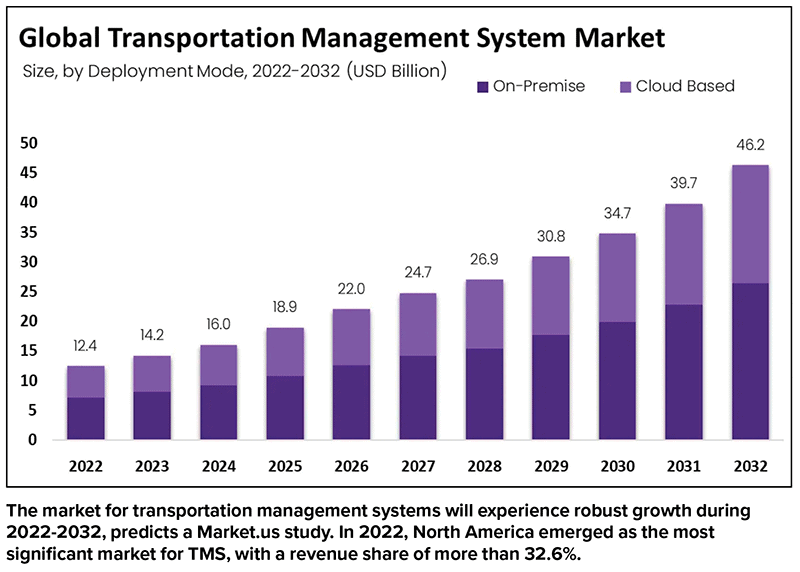The Route to the Right TMS

Transportation management systems (TMS) have evolved from an expense to an investment. But how do you choose the right one? What functionalities do you need? Follow this roadmap.
Nearly every shipper of any size currently uses some form of transportation management system (TMS). But not all TMS solutions are the same.
Perhaps you use legacy spreadsheets that break if a formula is updated. Or maybe your organization invested heavily in an on-premises solution 10 years ago, but technology and your business have left it behind. Or you’ve engaged with a third-party logistics provider that offers its own TMS solution as part of its services but you wonder what other options are available.
Given ongoing capacity constraints, multiplying distribution channels, and increasingly complex and volatile supply chains, organizations are looking for a better way to keep products moving at the right price at the right time. An outdated or inadequate TMS can stunt a company’s growth through higher costs and failure to meet customer expectations for delivery times and real-time tracking information.
“If your TMS is not providing the same level of support at each phase of your business growth, then it is time to look for an option that can support day-to-day operations while being flexible enough to support growing demand,” says Jeff McDermott, executive vice president of transportation management for GEODIS, a logistics services provider.
What is a TMS?
The right TMS can help companies reduce transportation costs and improve customer service by automating everyday tasks and connecting with the larger transportation ecosystem. At the base level, a TMS is a logistics technology platform that helps business plan, manage, and optimize the physical movement of inbound and outbound goods.
Overall, a TMS can deliver savings of 5 to 15% from optimized lanes and modes compared to the market, says R.J. Romano, supply chain advisory practice leader for consulting firm BDO USA.
With so many TMS options on the market, the key functionalities to look for include the ability to plan, execute, manage, settle, monitor, and model, whether you are a shipper, a third-party logistics (3PL) provider, or a carrier.
“A TMS enables the transparency and visibility required in today’s world of complex ecommerce and global supply chains,” Romano says.
Lower Costs
Thanks to advances such as cloud-based Software-as-a-Service (SaaS) computing, modern TMS solutions deliver powerful functionality at a lower cost than previous technology, opening the door for different service models that allow a wide range of companies to take advantage of their benefits.
For example, the needs of a small domestic shipper are much different than a multi-national company.
“The size and scale of your network will determine the size and scale of the TMS you need,” says Bryant Smith, director of product management for TMS at supply chain software supplier Manhattan Associates.
“If you have a small network with a small footprint, you probably don’t need an enterprise-level TMS that handles domestic, international, and multimodal transportation,” he adds.
When Lorena Camargo, founder of PearlTrans Logistics and a member of the board of directors of the Customized Logistics and Delivery Association, launched her business in 2011, she wanted to start off with a TMS.
“Even though at the beginning I didn’t have any revenue, I wanted to make sure I was able to have a technology component to offer our customers,” she says. “A TMS is often seen as an expense, but it’s really an investment.”
Improving Performance
A modern TMS can help your organization improve performance across the board. First, an organization can enable the existing team to be more effective in alleviating hiring challenges.
“Among transportation professionals, it’s still a tight labor market, so investments have to go into enabling technology rather than adding headcount,” says Dan Cicerchi, general manager and vice president of transportation management solutions for logistics technology company Descartes.
Second, a TMS supports management of a dynamic supply chain in inbound and outbound movements across multiple modes.
Third, it can help optimize pricing and service for carriers so your organization becomes a shipper of choice in the carrier community.
Before you begin researching a TMS, develop a roadmap of your company’s current needs and likely future growth.
“Shippers should start by defining their business goals operationally and technologically because that will influence the type of TMS provider they select,” Smith says.
Transportation spend is one way to categorize your TMS scope. A shipper that spends $10 million or less annually will have different requirements and expectations than a company that spends $100 million.
Network complexity is another selection factor. “If you have a $250 million truckload spend, but you’re not shipping LTL or parcel or anything else, you don’t need a sophisticated TMS,” says Nick Brown, transportation director at enVista, a supply chain consulting firm.
Identify Your Needs
Every TMS should offer essential functions relevant to almost every type of shipper. Then, there are nice-to-haves—additional capabilities that support specific uses or go beyond basic TMS functions.
“Identify your specific transportation and logistics needs, rank your current performance in each of these areas, and document the exact efficiencies and decision making that must change once your new TMS is implemented,” recommends Glenn Koepke, general manager of network collaboration at FourKites, a supply chain visibility platform.
Shippers should look for these essential features from their TMS provider.
- Carrier selection. The TMS should support choosing carriers based on previously negotiated bids using routing guide functionality with pre-built logic that incorporates ranking, cost, maximum loads, and allocations.
The TMS also should support spot bidding for last-minute orders or exceptions. - Integrations. Ensure the TMS connects with carriers and other technologies, such as warehouse management systems, enterprise resource planning systems, and real-time supply chain visibility platforms for a seamless end-to-end logistics solution.
Freight audit capability, whether native or third-party, eliminates manual auditing processes for faster payments. - Business intelligence and reporting. Data is king, and logistics performance management is contingent on seeing the results of decisions made.
- Mobile device access, document generation, and compliance management should also be on the list.
Ultimately, a TMS should connect all parties in your transportation network using digital systems instead of disparate tools and manual processes.
“Many systems only connect brokers to carriers or carriers to drivers or brokers to shippers, but they don’t connect every link that moves goods through the supply chain,” says Mehmed Tiro, CEO of Muftar, a supply chain technology provider. “A TMS that connects all parties makes processes more efficient and can help positively contribute to business growth,” he adds.
NICE-TO-HAVES
Beyond the basics, consider what other functions might be nice to have a TMS provide for your company.
A sophisticated TMS can develop predictive analytics to optimize more than pricing. An intelligent system will track spend on parcels, for example, and recommend moving to LTL service or trade-off air shipments for ground delivery for lower rates.
“Shippers are good at their business but may not be supply chain specialists,” says Frank DeSantis, chief operating officer of BrillDog, a TMS provider. “The TMS can be the expert for them.”
One of the most critical nice-to-haves is the flexibility to scale with your business without expensive custom programming. Some TMS options have a set of base features with additional capabilities available as needed.
“You want the flexibility to be able to toggle on or off certain features or tools,” says Ben Steffes, vice president of CTM & Managed Services at Coyote Logistics.
Understand what it takes to customize or update the TMS. With an on-premises solution, new functions, customized fields, or reports have to wait until the next update. A SaaS option can be updated continuously and customized quickly to meet changing demands.
“Waiting for updates puts you at a severe disadvantage against the competition because your competitors were adjusting on the fly to keep products on the shelves,” Smith says.
SELF-SERVICE VS. MANAGED
With the proliferation of SaaS options, shippers can choose a free or low-cost self-service option or a full-service solution with a managed-provider relationship.
Some TMS solutions, such as BrillDog and Coyote Logistics, offer a free option for basic transportation needs. “If you need to just ship LTL products, you can do that without paying a management or subscription fee; you just pay to move your freight,” DeSantis says.
A managed service tier may be the answer if a shipper is looking for a deeper, consultative relationship. For companies that require more, a managed transportation relationship with a 3PL includes a TMS as well as a dedicated team to oversee execution and carrier relationships.
A third-party logistics provider may have developed its own TMS or have a few preferred solutions. Brokers may also offer a TMS but may limit carriers to their preferred list.
With today’s rapid technological advances and the volatile supply chain environment, shippers shouldn’t wait until their current TMS solution shows its deficiencies at a critical moment.
“Shippers should always be on the lookout because you don’t know what you don’t know,” DeSantis says. “You’ve got to be proactive.”

5 QUICK TIPS FOR DEPLOYING A TMS
1. Plan first. Develop a detailed deployment plan with steps, timelines, resources, and responsibilities.
2. Stakeholder buy-in. A TMS project is team-based, so IT, supplier management, customer service, logistics, warehousing, procurement, and others must be involved with clear lines of ownership and responsibility.
3. Change management. Documented testing and user training will make things go smoother.
4. Phased deployment. Start with small wins that develop momentum for success.
5. Plan for review. Budget for consulting services to review configurations, optimizations, routing guides, and more.
